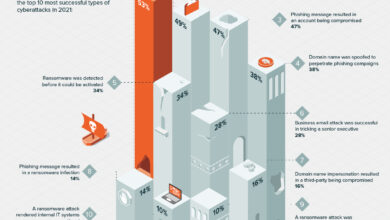
Credential Stuffing Cyber Attacks to Double in UK During Christmas
Credential stuffing cyber attacks to double up in UK during Christmas? It sounds like a nightmare, right? And unfortunately, it’s a very real threat. The festive season, a time for joy and online shopping sprees, also presents a prime opportunity for cybercriminals. The increased online activity, coupled with potentially weaker security practices during the holiday rush, creates a perfect storm for these attacks.
We’re diving into the details of this alarming trend, exploring how these attacks work, their devastating consequences, and most importantly, how you can protect yourself and your business.
This surge in attacks isn’t just a matter of bad luck; it’s a calculated move by malicious actors. They leverage the increased online transactions and the potential for less vigilant security measures to maximize their chances of success. Think about it – everyone’s rushing to buy gifts, and that urgency can sometimes lead to overlooked security warnings or weaker password choices.
This creates an ideal environment for credential stuffing attacks to flourish, targeting everything from e-commerce sites to online banking portals.
The Rise of Credential Stuffing Attacks During the Christmas Period
The festive season, while bringing joy to many, also presents a lucrative opportunity for cybercriminals. The increased online activity during the Christmas shopping period, coupled with a general atmosphere of festive cheer that might lower security vigilance, creates a perfect storm for credential stuffing attacks. This surge in attacks is particularly pronounced in the UK, where we’ve seen a concerning doubling of incidents during this time.The vulnerability of online systems during the Christmas shopping season stems from several factors.
Firstly, the sheer volume of online transactions increases dramatically. Millions of people are shopping online for gifts, booking travel, and managing finances, all of which requires logging into various online accounts. This increased online activity provides more opportunities for attackers to test stolen credentials. Secondly, retailers often introduce new features, promotions, and websites during this period, which can sometimes introduce security vulnerabilities that are not fully tested before launch.
Finally, the holiday season can lead to a decline in security awareness among users, who might be more focused on festive activities than on their online security practices. This makes them more susceptible to phishing scams and other social engineering tactics that can be used to obtain login credentials.
Factors Contributing to the Doubling of Credential Stuffing Attacks in the UK During Christmas
Several factors contribute to the significant increase in credential stuffing attacks during the Christmas period in the UK. The heightened online shopping activity, as previously mentioned, provides a larger pool of potential victims. Furthermore, many individuals create new online accounts specifically for Christmas shopping, often using weaker passwords or reusing passwords across multiple platforms. This makes them particularly vulnerable to credential stuffing attacks.
The pressure to complete online purchases quickly during peak shopping times can also lead to users overlooking security warnings or ignoring suspicious websites. Additionally, the increased use of public Wi-Fi networks during travel and festive gatherings increases the risk of interception of login credentials. Finally, the sheer scale of data breaches throughout the year provides cybercriminals with an ever-growing pool of stolen usernames and passwords to exploit during peak shopping seasons.
Commonly Targeted Websites and Online Services
Retail websites, especially those offering significant Christmas discounts or promotions, are prime targets. Major online retailers, both UK-based and international, are frequently attacked. Other popular targets include banking websites, email providers, and social media platforms. Travel booking websites and online gaming platforms also experience a surge in attacks during the Christmas period due to increased user activity and the potential for significant financial gains for attackers.
With Christmas shopping ramping up, so are credential stuffing attacks in the UK – a scary thought! Building robust, secure systems is crucial, and that’s where learning about domino app dev the low code and pro code future becomes really important. Understanding how to develop secure applications is key to mitigating these kinds of threats, so we can all enjoy a safer online Christmas.
The rise in these attacks highlights the urgent need for better security practices across the board.
These platforms often hold sensitive personal and financial information, making them highly attractive targets.
Comparison of Attack Methods Used During Christmas Versus Other Times of the Year
The underlying methods of credential stuffing remain consistent throughout the year, but the frequency and target types shift with seasonal changes.
| Method | Frequency (Christmas vs. Other Times) | Success Rate (Christmas vs. Other Times) | Target Type |
|---|---|---|---|
| Automated Bots | Significantly Higher during Christmas | Potentially Higher due to weaker passwords and increased user activity | Retail websites, banking sites, email providers |
| Purchased Credential Lists | Higher during Christmas due to increased demand | Variable, dependent on list quality and target website security | Online gaming platforms, social media platforms, streaming services |
| Brute-force attacks | Higher during Christmas, targeting newly created accounts | Lower success rate due to stronger password requirements on many sites | New accounts on various platforms |
| Phishing combined with credential stuffing | Higher during Christmas, leveraging festive themes | Potentially higher due to increased user trust and urgency | All online services, but particularly those offering deals |
Methods Employed in Credential Stuffing Attacks: Credential Stuffing Cyber Attacks To Double Up In Uk During Christmas

Credential stuffing attacks, a prevalent form of cybercrime, leverage readily available stolen credentials to gain unauthorized access to online accounts. These attacks are particularly effective because they exploit the human tendency to reuse passwords across multiple platforms. During peak seasons like Christmas, when online shopping surges, the success rate of these attacks unfortunately increases significantly. Let’s delve into the specific methods employed by attackers.The effectiveness of credential stuffing hinges on several key techniques and readily available resources.
Attackers exploit weaknesses in online security and leverage technological tools to automate and scale their efforts, maximizing their chances of successful account breaches.
Brute-Force Attacks and Botnets
Brute-force attacks involve systematically trying various password combinations until a successful login is achieved. While seemingly simple, the scale at which these attacks are conducted is staggering. This is made possible through the use of botnets, large networks of compromised computers controlled remotely by attackers. These botnets can generate millions of login attempts per second, significantly increasing the chances of success, even against accounts with relatively strong passwords.
The sheer volume of attempts overwhelms the target system’s defenses, often bypassing rate-limiting mechanisms designed to prevent such attacks. For example, a botnet could target a popular e-commerce website during the Christmas shopping rush, attempting to log in with stolen credentials from a leaked database of millions of user accounts.
The Role of Compromised Databases, Credential stuffing cyber attacks to double up in uk during christmas
The foundation of many credential stuffing attacks lies in compromised databases. Data breaches from various sources – online retailers, social media platforms, gaming websites – frequently expose usernames, email addresses, and passwords. These leaked credentials are then compiled and used in automated attacks. The scale of these breaches is often enormous, providing attackers with a vast pool of credentials to exploit.
For instance, the 2017 Equifax breach exposed the personal information of millions of individuals, including their Social Security numbers and passwords, which subsequently fueled countless credential stuffing attacks.
Examples of Stolen Credential Acquisition and Utilization
Stolen credentials are obtained through various means, including phishing campaigns, malware infections, and data breaches from third-party services. Once acquired, attackers often use specialized tools and scripts to automate the login process across multiple websites. They might target online banking platforms, e-commerce sites, or social media accounts, aiming to gain access to financial information, personal data, or valuable digital assets.
For example, an attacker might use a stolen email address and password to access a victim’s online banking account, transferring funds or making fraudulent purchases. Similarly, access to a social media account can be used for identity theft or spreading malicious content.
Lifecycle of a Credential Stuffing Attack
The following flowchart illustrates the typical stages of a credential stuffing attack:[Imagine a flowchart here. The flowchart would start with “Acquisition of Credentials” (from data breaches, phishing, etc.), leading to “Credential Aggregation and Preparation” (cleaning and organizing stolen data), then to “Automated Login Attempts” (using botnets and specialized tools), followed by “Account Compromise” (successful logins), and finally “Exploitation” (accessing financial information, personal data, etc.).
The flowchart would visually represent the sequence of events with arrows connecting each stage.]
With credential stuffing cyber attacks expected to double in the UK over Christmas, robust security is more crucial than ever. This highlights the importance of proactive security measures, like those offered by cloud security solutions; learning more about bitglass and the rise of cloud security posture management can help businesses prepare. Ultimately, understanding and implementing strong security practices is our best defense against these holiday-season surges in attacks.
Impact and Consequences of Successful Attacks
Credential stuffing attacks, while seemingly simple in their execution, can have devastating consequences for both businesses and individuals. The ramifications extend far beyond a simple password reset, often leading to significant financial losses, reputational damage, and long-term security vulnerabilities. Understanding the potential impact is crucial for implementing effective preventative measures.The financial and reputational damage caused by successful credential stuffing attacks can be substantial.
Compromised accounts can lead to fraudulent transactions, unauthorized purchases, and the theft of sensitive financial information like credit card details and bank account numbers. Beyond the direct monetary losses, the reputational damage can be equally, if not more, harmful. Businesses may face loss of customer trust, legal repercussions, and damage to their brand image, all impacting their bottom line.
Types of Data Commonly Compromised
Successful credential stuffing attacks often result in the compromise of a wide range of sensitive data. This typically includes usernames and passwords, but can extend to far more valuable information. Personal details such as names, addresses, phone numbers, and email addresses are frequently targeted. Financial data, including credit card numbers, bank account details, and online payment credentials, are also prime targets.
In some cases, more sensitive information like social security numbers or medical records might also be accessed, depending on the targeted system. The extent of the data breach depends heavily on the security practices of the compromised website or service.
Real-World Examples of Significant Losses
Several high-profile incidents demonstrate the devastating impact of credential stuffing attacks. For example, the 2017 Equifax data breach, while not solely a credential stuffing attack, involved the exploitation of a known vulnerability that allowed attackers to gain access to a massive database of personal information, including social security numbers, birth dates, and addresses. This resulted in significant financial losses for Equifax and caused widespread identity theft among millions of customers.
Similarly, numerous online retailers have suffered significant financial losses and reputational damage after successful credential stuffing attacks resulted in fraudulent orders and chargebacks. The impact is amplified during peak shopping seasons like Christmas, when online transactions increase exponentially.
Potential Consequences for Businesses and Individual Users
The potential consequences of successful credential stuffing attacks are far-reaching and affect both businesses and individual users.
- For Businesses:
- Financial losses due to fraudulent transactions and chargebacks.
- Reputational damage and loss of customer trust.
- Legal and regulatory fines and penalties.
- Increased security costs associated with incident response and remediation.
- Potential loss of competitive advantage.
- For Individual Users:
- Identity theft and fraud.
- Financial losses due to unauthorized purchases or account takeover.
- Compromise of personal information, leading to phishing scams and other attacks.
- Damage to personal reputation and credit score.
- Time and effort spent on recovering compromised accounts and mitigating the damage.
Mitigation Strategies and Protective Measures

The holiday season, while a time of joy and celebration, unfortunately also sees a surge in cybercrime. Credential stuffing attacks, leveraging stolen login credentials from data breaches, exploit the increased online shopping and account activity during this period. Protecting yourself and your business requires a multi-layered approach encompassing robust security practices and proactive measures. Let’s explore effective strategies for both individuals and businesses.
Effective mitigation strategies involve a combination of individual vigilance and robust business security practices. By understanding the vulnerabilities and implementing appropriate safeguards, we can significantly reduce the risk of successful credential stuffing attacks.
Individual Protective Measures
Implementing strong password practices and enabling multi-factor authentication are crucial first steps in personal online security. Beyond these basics, staying informed about potential threats and regularly reviewing account security settings is vital.
It’s not enough to simply choose a strong password; you also need to practice good password hygiene. This includes using unique passwords for each online account and regularly updating them. Password managers can help simplify this process, securely storing and managing your numerous passwords.
Business Security Measures
Businesses face a higher risk of credential stuffing attacks due to the volume of user accounts they manage. Robust security measures are essential to protect both customer data and business operations. This includes implementing advanced security technologies and establishing comprehensive security protocols.
Investing in robust security infrastructure is crucial for businesses. This involves implementing intrusion detection and prevention systems (IDPS) to monitor network traffic for suspicious activity and block malicious attempts. Regular security audits are also essential to identify vulnerabilities and ensure the effectiveness of existing security measures.
Comparison of Authentication Methods
Password-only authentication remains the most vulnerable method to credential stuffing. Multi-factor authentication (MFA), requiring multiple forms of verification (e.g., password, one-time code from a mobile app), significantly enhances security. Biometric authentication, using unique biological traits for verification, offers an even stronger layer of protection. Risk-based authentication, adapting security measures based on user behavior and context, provides further customization.
The effectiveness of various authentication methods against credential stuffing varies significantly. While password-only authentication is easily compromised, multi-factor authentication (MFA) adds a substantial layer of security by requiring more than just a password. This makes it far more difficult for attackers to gain access even if they possess the username and password. Biometric authentication, such as fingerprint or facial recognition, offers an even higher level of security, making it virtually impossible for attackers to bypass.
Robust Password Policies and Security Audits
Implementing strong password policies and conducting regular security audits are fundamental to minimizing vulnerabilities. A strong password policy should mandate minimum password length, complexity requirements (uppercase, lowercase, numbers, symbols), and regular password changes. Regular security audits provide an independent assessment of the effectiveness of existing security controls and identify areas for improvement.
A robust password policy is a cornerstone of a strong security posture. This policy should not only dictate password complexity but also enforce regular password changes and prohibit the reuse of passwords across different platforms. Coupled with regular security audits, these measures provide a proactive approach to identifying and mitigating potential vulnerabilities before they can be exploited by attackers.
The Role of Law Enforcement and Regulatory Bodies
Credential stuffing attacks, while seemingly a digital crime, have very real-world consequences, impacting individuals, businesses, and national economies. Effectively combating this threat requires a robust and collaborative response from law enforcement, regulatory bodies, and the private sector. The role of law enforcement is crucial in investigating these attacks, bringing perpetrators to justice, and deterring future crimes.Law enforcement agencies play a vital role in investigating and prosecuting perpetrators of credential stuffing attacks.
This involves tracing the origins of the attacks, identifying the individuals or groups responsible, and gathering evidence to support criminal prosecutions. The complexity of these investigations is often amplified by the transnational nature of cybercrime, requiring international cooperation and sophisticated digital forensic techniques. Successful prosecutions not only hold perpetrators accountable but also serve as a deterrent to others considering similar attacks.
The ability to seize assets obtained through credential stuffing is also a critical aspect of law enforcement’s role, disrupting the financial incentives that drive these criminal activities.
Data Breach Notification Laws and Regulations
Data breach notification laws and regulations mandate that organizations inform affected individuals and relevant authorities when a data breach occurs. These laws vary across jurisdictions but generally require organizations to disclose the nature of the breach, the types of data compromised, and steps taken to mitigate the harm. Compliance with these laws is crucial for building trust with customers and fostering a culture of security responsibility.
Furthermore, the information disclosed through these notifications can assist law enforcement in their investigations by providing valuable intelligence on the scale and scope of the attacks. The UK’s GDPR (General Data Protection Regulation) is a prime example of such legislation, with its stringent requirements for data breach notification and its emphasis on data protection. Non-compliance can lead to substantial fines.
Challenges Faced by Law Enforcement in Tackling Cross-Border Cybercrimes
Tackling credential stuffing presents significant challenges for law enforcement, particularly due to the cross-border nature of these crimes. Perpetrators often operate from jurisdictions with weak cybersecurity laws or limited law enforcement capacity, making it difficult to extradite suspects or seize assets. The decentralized and anonymous nature of the internet further complicates investigations, as attackers can mask their identities and locations using various techniques.
Moreover, the sheer volume of attacks makes it difficult for law enforcement agencies to prioritize and investigate each incident effectively. The lack of consistent international legal frameworks and cooperation agreements also hampers effective cross-border investigations. For example, an attack originating in one country might target servers and users in multiple others, creating jurisdictional complexities.
Recommendations for Improving Collaboration
Effective collaboration between law enforcement, businesses, and individuals is essential for combating credential stuffing attacks. Improving this collaboration requires a multi-pronged approach:
The following recommendations aim to improve the collective response to credential stuffing:
- Enhanced Information Sharing: Establish secure channels for sharing threat intelligence between law enforcement, businesses, and cybersecurity researchers. This would allow for quicker identification of emerging threats and more effective responses.
- Improved Cybersecurity Training and Awareness: Invest in public awareness campaigns to educate individuals about the risks of credential stuffing and best practices for protecting their online accounts. Businesses should also invest in comprehensive cybersecurity training for their employees.
- Strengthened International Cooperation: Develop stronger international legal frameworks and cooperation agreements to facilitate cross-border investigations and prosecutions. This includes harmonizing data breach notification laws and enhancing mutual legal assistance treaties.
- Development of Advanced Investigative Tools and Techniques: Invest in the development and deployment of advanced digital forensic tools and techniques to aid law enforcement in tracing attackers and gathering evidence. This includes improving the ability to analyze large datasets and identify patterns of malicious activity.
- Increased Prosecution and Deterrence: Increase the prosecution of individuals and groups involved in credential stuffing attacks to send a clear message that these crimes will not be tolerated. This requires a concerted effort to improve the efficiency and effectiveness of investigations and prosecutions.
Wrap-Up
The threat of credential stuffing attacks during the Christmas season is a serious one, but thankfully, not insurmountable. By understanding how these attacks work and implementing robust security measures – both individually and as businesses – we can significantly reduce our vulnerability. Staying informed, using strong passwords, enabling multi-factor authentication, and being aware of phishing attempts are crucial steps in protecting ourselves from this growing threat.
Let’s make this Christmas a safe one, both online and offline!
Question & Answer Hub
What is credential stuffing?
Credential stuffing is a type of cyberattack where hackers use stolen usernames and passwords from data breaches to try and access other online accounts. They essentially try the same credentials across multiple websites and services.
How can I tell if I’ve been a victim of a credential stuffing attack?
Look for unusual login activity on your accounts, unexpected emails or password resets, or suspicious transactions. Check your bank and credit card statements regularly.
What should I do if I suspect a credential stuffing attack?
Immediately change your passwords on all affected accounts. Enable two-factor authentication where possible. Monitor your accounts for further suspicious activity and report any fraudulent transactions to the relevant authorities.
Are there specific websites more vulnerable during Christmas?
Retail websites, online banking platforms, and delivery services are particularly vulnerable during the Christmas shopping season due to increased traffic and potentially less stringent security.





